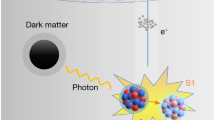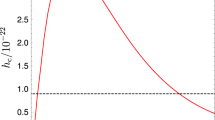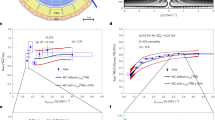Abstract
Observations of galaxies and primordial radiation suggest that the Universe is made mostly of non-luminous dark matter1,2. Several new types of fundamental particle have been proposed as candidates for dark matter3, such as weakly interacting massive particles (WIMPs)4,5. These particles would be expected to interact with nuclei in suitable detector materials on Earth, for example, causing them to recoil. However, no definitive signal from such dark-matter interactions has been detected despite concerted efforts by many collaborations6. One exception is the much-debated claim by the DAMA collaboration of a statistically significant (more than nine standard deviations) annual modulation in the rate of nuclear interaction events. Annual modulation is expected because of the variation in Earth’s velocity relative to the Galaxy’s dark-matter halo that arises from Earth’s orbital motion around the Sun. DAMA observed a modulation in the rate of interaction events in their detector7,8,9 with a period and phase consistent with that expected for WIMPs10,11,12. Several groups have been working to develop experiments with the aim of reproducing DAMA’s results using the same target medium (sodium iodide)13,14,15,16,17. To determine whether there is evidence for an excess of events above the expected background in sodium iodide and to look for evidence of an annual modulation, the COSINE-100 experiment uses sodium iodide as the target medium to carry out a model-independent test of DAMA’s claim. Here we report results from the initial operation of the COSINE-100 experiment related to the first task18,19. We observe no excess of signal-like events above the expected background in the first 59.5 days of data from COSINE-100. Assuming the so-called standard dark-matter halo model, this result rules out spin-independent WIMP–nucleon interactions as the cause of the annual modulation observed by the DAMA collaboration20,21,22,23. The exclusion limit on the WIMP–sodium interaction cross-section is 1.14 × 10−40 cm2 for 10-GeV c−2 WIMPs at a 90% confidence level. The COSINE-100 experiment will continue to collect data for two more years, enabling a model-independent test of the annual modulation observed by the DAMA collaboration.
This is a preview of subscription content, access via your institution
Access options
Access Nature and 54 other Nature Portfolio journals
Get Nature+, our best-value online-access subscription
$29.99 / 30 days
cancel any time
Subscribe to this journal
Receive 51 print issues and online access
$199.00 per year
only $3.90 per issue
Buy this article
- Purchase on Springer Link
- Instant access to full article PDF
Prices may be subject to local taxes which are calculated during checkout




Similar content being viewed by others
Change history
21 January 2019
In this Letter, owing to an error during the production process, ‘spin-independent’ was omitted from a sentence in the Abstract, which should read: “Assuming the so-called standard dark-matter halo model, this result rules out spin-independent WIMP–nucleon interactions as the cause of the annual modulation observed by the DAMA collaboration”. This omission has been corrected online.
References
Clowe, D. et al. A direct empirical proof of the existence of dark matter. Astrophys. J. 648, L109–L113 (2006).
Ade, P. A. R. et al. Planck 2015 results. XIII. Cosmological parameters. Astron. Astrophys. 594, A13 (2016).
Baer, H., Choi, K.-Y., Kim, J. E. & Roszkowski, L. Dark matter production in the early Universe: beyond the thermal WIMP paradigm. Phys. Rep. 555, 1–60 (2015).
Lee, B. W. & Weinberg, S. Cosmological lower bound on heavy-neutrino masses. Phys. Rev. Lett. 39, 165–168 (1977).
Goodman, M. W. & Witten, E. Detectability of certain dark matter candidates. Phys. Rev. D 31, 3059–3063 (1985).
Battaglieri, M. et al. US cosmic visions: new ideas in dark matter 2017: community report. Preprint at https://arxiv.org/abs/1707.04591 (2017).
Bernabei, R. et al. Searching for WIMPs by the annual modulation signature. Phys. Lett. B 424, 195–201 (1998).
Bernabei, R. et al. Final model independent result of DAMA/LIBRA-phase1. Eur. Phys. J. C 73, 2648 (2013).
Bernabei, R. et al. First model independent results from DAMA/LIBRA-phase2. Preprint at https://arxiv.org/abs/1805.10486 (2018).
Savage, C., Gelmini, G., Gondolo, P. & Freese, K. Compatibility of DAMA/LIBRA dark matter detection with other searches. J. Cosmol. Astropart. Phys. 4, 10 (2009).
Baum, S., Freese, K. & Kelso, C. Dark matter implications of DAMA/LIBRA-phase2 results. Preprint at https://arxiv.org/abs/1804.01231 (2018).
Kang, S., Scopel, S., Tomar, G. & Yoon, J.-H. DAMA/LIBRA-phase2 in WIMP effective models. J. Cosmol. Astropart. Phys. 7, 16 (2018).
Barbosa de Souza, E. et al. First search for a dark matter annual modulation signal with NaI(Tl) in the Southern Hemisphere by DM-Ice17. Phys. Rev. D 95, 032006 (2017).
Amaré, J. et al. Status of the ANAIS dark matter project at the Canfranc Underground Laboratory. J. Phys. Conf. Ser. 718, 042052 (2016).
Fushimi, K. et al. Dark matter search project PICO-LON. J. Phys. Conf. Ser. 718, 042022 (2016).
Xu, J., Calaprice, F., Froborg, F., Shields, E. & Suerfu, B. SABRE – a test of DAMA with high-purity NaI(Tl) crystals. AIP Conf. Proc. 1672, 040001 (2015).
Adhikari, P. et al. Understanding internal backgrounds in NaI(Tl) crystals toward a 200 kg array for the KIMS-NaI experiment. Eur. Phys. J. C 76, 185 (2016).
Adhikari, G. et al. Initial performance of the COSINE-100 experiment. Eur. Phys. J. C 78, 107 (2018).
Adhikari, P. et al. Background model for the NaI(Tl) crystals in COSINE-100. Eur. Phys. J. C 78, 490 (2018).
Tanabashi, M. et al. The review of particle physics. Phys. Rev. D 98, 030001 (2018).
Drukier, A. K., Freese, K. & Spergel, D. N. Detecting cold dark-matter candidates. Phys. Rev. D 33, 3495–3508 (1986).
Freese, K., Frieman, J. A. & Gould, A. Signal modulation in cold dark matter detection. Phys. Rev. D 37, 3388–3405 (1988).
Lewin, J. & Smith, P. Review of mathematics, numerical factors, and corrections for dark matter experiments based on elastic nuclear recoil. Astropart. Phys. 6, 87–112 (1996).
Park, J. S. et al. Performance of a prototype active veto system using liquid scintillator for a dark matter search experiment. Nucl. Instrum. Methods A 851, 103–107 (2017).
Prihtiadi, H. et al. Muon detector for the COSINE-100 experiment. J. Instrum. 13, T02007 (2018).
Friedman, J. H. Greedy function approximation: a gradient boosting machine. Ann. Stat. 29, 1189–1232 (2001).
Agostinelli, S. et al. GEANT4: a simulation toolkit. Nucl. Instrum. Methods A 506, 250–303 (2003).
Swiderski, L. Response of doped alkali iodides measured with gamma-ray absorption and Compton electrons. Nucl. Instrum. Methods A 705, 42–46 (2013).
Caldwell, A., Kollár, D. & Kröninger, K. BAT – the Bayesian analysis toolkit. Comput. Phys. Commun. 180, 2197–2209 (2009).
Alner, G. J. et al. Limits on WIMP cross-sections from the NAIAD experiment at the Boulby Underground Laboratory. Phys. Lett. B 616, 17–24 (2005).
Adhikari, G. et al. The COSINE-100 data acquisition system. J. Instrum. 13, P09006 (2018).
Sala, E. et al. Development of an underground low background instrument for high sensitivity measurements. J. Phys. Conf. Ser. 718, 062050 (2016).
Pettus, W. C. Cosmogenic Activation in NaI Detectors for Dark Matter Searches. PhD thesis, Univ. Wisconsin–Madison (2015).
Acknowledgements
We thank the Korea Hydro and Nuclear Power (KHNP) Company for providing underground laboratory space at Yangyang. This work is supported by: the Institute for Basic Science (IBS) under project code IBS-R016-A1 and NRF-2016R1A2B3008343, South Korea; UIUC campus research board, the Alfred P. Sloan Foundation Fellowship, NSF grant numbers PHY-1151795, PHY-1457995, DGE-1122492 and DGE-1256259, WIPAC, the Wisconsin Alumni Research Foundation, Yale University and DOE/NNSA grant number DE-FC52-08NA28752, USA; STFC grants ST/N000277/1 and ST/K001337/1, UK; and CNPq and grant number 2017/02952-0 FAPESP, Brazil.
Reviewer information
Nature thanks B. Sadoulet and the other anonymous reviewer(s) for their contribution to the peer review of this work.
Author information
Authors and Affiliations
Consortia
Contributions
Y.K., H.S.L., R.H.M. and N.J.C.S. conceived the COSINE-100 experiment. Its design and installation were led by K.P. and C.H.H. and carried out by all members of the collaboration. Operation and maintenance were organized by C.H.H. with support from on-site crews, W.G.K., B.K. and S.H.Y. Jaison Lee, J.P., J.H.J., G.A., P.A., H. Prihtiadi, C.H.H., W.G.T., E.B.d.S., H.S.L. and K.K. contributed to data acquisition, production and verification. H.J., Hyeonseo Park and K.K. provided nuclear recoil data. P.A., G.A., J.P., K.K., H. Prihtiadi, N.Y.K. and C.H.H. performed the source calibrations. Hyounggyu Kim, N.Y.K., C.H.H. and H.S.L. developed the slow control framework. J.H.J. and W.G.T. developed the data monitoring package. N.Y.K., Jooyoung Lee and Y.J.K. provided the radiopurity of the detector materials. G.A., J.P. and N.Y.K. produced the liquid scintillator. Background simulations were performed by F.M., E.J., P.A., W.G.T. and E.B.d.S. C.H.H. and P.A. analysed the observational and simulated data. The manuscript and plots were produced by C.H.H. and H.S.L., and edited by R.H.M., S.L.O., N.J.C.S. and the other members of the collaboration. All authors participated in online data-monitoring shifts and approved the manuscript. Authors are listed alphabetically by their last names.
Ethics declarations
Competing interests
The authors declare no competing interests.
Additional information
Publisher’s note: Springer Nature remains neutral with regard to jurisdictional claims in published maps and institutional affiliations.
Extended data figures and tables
Extended Data Fig. 1 The COSINE-100 detector.
a, The detector is contained within a nested arrangement of shielding components, as indicated by different colours. The main purpose of the shield is to provide 4π coverage against external radiation from various background sources. The shielding components include plastic scintillator panels (blue), a lead brick enclosure (grey) and a copper box (reddish brown). b, c, The eight encapsulated sodium iodide crystal assemblies (c) are located inside the copper box and are immersed in scintillating liquid (b). All images are schematic.
Extended Data Fig. 2 Typical waveforms from the COSINE-100 PMTs for 2–6-keV signals.
a, The β and γ scintillation signals have a fast rise and then fall off with a decay time of about 250 ns. The waveform from WIMPs is expected to closely resemble the β and γ waveforms. b, c, Background waveforms from PMT noise (b) and external discharge (c).
Extended Data Fig. 3 The BDT output (horizontal) versus the BDTA output (vertical).
a, b, Events (colour scale) with energies below 10 keV are shown for two separate crystals, with (a) and without (b) PMT discharge. The events to the right and above the red dotted lines are scintillation events induced by real particle–crystal interactions. PMT noise events are to the left of the vertical dotted lines in both panels; PMT discharge events are below the horizontal dotted line in a.
Extended Data Fig. 4 A comparison between data and simulation.
a–d, Four categories of data are shown: single-hit low-energy (2–70 keV; a); single-hit high-energy (70–3,000 keV; b); multiple-hit low-energy (2–70 keV; c); and multiple-hit high-energy (70–3,000 keV; d). The black points (with errors bars indicating the 68% confidence interval) are data. The green (yellow) band shows the ±1σ (±2σ) uncertainty range of the model. The peak near 3 keV in the multiple-hit, low-energy spectrum (c) is due to the tagged 40K events. The inset in a shows a zoomed-in view in the region of interest after efficiency corrections are applied. The major contributors to the radioactive background are labelled.
Extended Data Fig. 5 Crystal-by-crystal fit results.
a–f, The points (with errors bars indicating the 68% confidence interval) show the measured energy spectra for each of the six crystals. The fit results are shown as blue histograms, with the ±1σ (±2σ) error bands shown in green (yellow). To compare the signal strength of the DAMA sodium region with our data, a 10 GeV c−2 WIMP signal at 2.35 × 10−40 cm2 (the centre of the DAMA sodium region) is indicated for each crystal as a red histogram. The fit residuals, together with the expectations for the 10 GeV c−2 WIMP signal are also shown (bottom panels).
Rights and permissions
About this article
Cite this article
The COSINE-100 Collaboration. An experiment to search for dark-matter interactions using sodium iodide detectors. Nature 564, 83–86 (2018). https://doi.org/10.1038/s41586-018-0739-1
Received:
Accepted:
Published:
Issue Date:
DOI: https://doi.org/10.1038/s41586-018-0739-1
Keywords
This article is cited by
-
Emulator-based Bayesian inference on non-proportional scintillation models by compton-edge probing
Nature Communications (2023)
-
Einstein rings modulated by wavelike dark matter from anomalies in gravitationally lensed images
Nature Astronomy (2023)
-
Dark matter substructures affect dark matter-electron scattering in xenon-based direct detection experiments
Journal of High Energy Physics (2023)
-
Binary collisions of dark matter blobs
Journal of High Energy Physics (2023)
-
An induced annual modulation signature in COSINE-100 data by DAMA/LIBRA’s analysis method
Scientific Reports (2023)
Comments
By submitting a comment you agree to abide by our Terms and Community Guidelines. If you find something abusive or that does not comply with our terms or guidelines please flag it as inappropriate.



